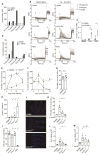Detection of Succinate by Intestinal Tuft Cells Triggers a Type 2 Innate Immune Circuit
- PMID: 30021144
- PMCID: PMC6084797
- DOI: 10.1016/j.immuni.2018.06.016
Detection of Succinate by Intestinal Tuft Cells Triggers a Type 2 Innate Immune Circuit
Abstract
In the small intestine, type 2 responses are regulated by a signaling circuit that involves tuft cells and group 2 innate lymphoid cells (ILC2s). Here, we identified the microbial metabolite succinate as an activating ligand for small intestinal (SI) tuft cells. Sequencing analyses of tuft cells isolated from the small intestine, gall bladder, colon, thymus, and trachea revealed that expression of tuft cell chemosensory receptors is tissue specific. SI tuft cells expressed the succinate receptor (SUCNR1), and providing succinate in drinking water was sufficient to induce a multifaceted type 2 immune response via the tuft-ILC2 circuit. The helminth Nippostrongylus brasiliensis and a tritrichomonad protist both secreted succinate as a metabolite. In vivo sensing of the tritrichomonad required SUCNR1, whereas N. brasiliensis was SUCNR1 independent. These findings define a paradigm wherein tuft cells monitor microbial metabolites to initiate type 2 immunity and suggest the existence of other sensing pathways triggering the response to helminths.
Keywords: ILC2; chemosensing; helminth; nippostrongylus brasiliensis; protist; small intestine; succinate; tritrichomonas; tuft cell; type 2 immunity.
Copyright © 2018 Elsevier Inc. All rights reserved.
Conflict of interest statement
The authors declare no competing interests.
Figures




Comment in
-
Getting a Taste for Parasites in the Gut.Immunity. 2018 Jul 17;49(1):16-18. doi: 10.1016/j.immuni.2018.07.002. Immunity. 2018. PMID: 30021142
References
-
- Barker N. Adult intestinal stem cells: critical drivers of epithelial homeostasis and regeneration. Nat Rev Mol Cell Biol. 2014;15:19–33. - PubMed
-
- Bezençon C, Fürholz A, Raymond F, Mansourian R, Métairon S, Le Coutre J, Damak S. Murine intestinal cells expressing Trpm5 are mostly brush cells and express markers of neuronal and inflammatory cells. J Comp Neurol. 2008;509:514–525. - PubMed
Publication types
MeSH terms
Substances
Grants and funding
LinkOut - more resources
Full Text Sources
Other Literature Sources
Molecular Biology Databases
Research Materials

